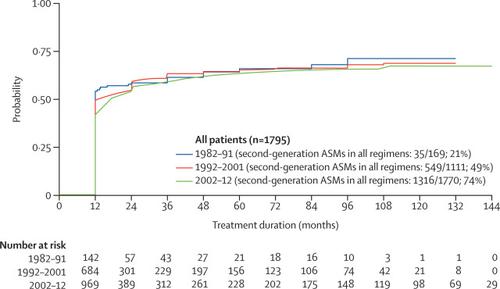当前位置:
X-MOL 学术
›
Lancet Neurol.
›
论文详情
Our official English website, www.x-mol.net, welcomes your feedback! (Note: you will need to create a separate account there.)
30 years of second-generation antiseizure medications: impact and future perspectives
The Lancet Neurology ( IF 48.0 ) Pub Date : 2020-06-01 , DOI: 10.1016/s1474-4422(20)30035-1 Emilio Perucca 1 , Martin J Brodie 2 , Patrick Kwan 3 , Torbjörn Tomson 4
The Lancet Neurology ( IF 48.0 ) Pub Date : 2020-06-01 , DOI: 10.1016/s1474-4422(20)30035-1 Emilio Perucca 1 , Martin J Brodie 2 , Patrick Kwan 3 , Torbjörn Tomson 4
Affiliation

|
Since 1989, 18 second-generation antiseizure medications have reached the market, resulting in a greatly increased range of treatment options for patients and prescribers. 30 years have passed and now is the time for an appraisal of the effect of these medications on clinical outcomes. Every antiseizure medication needs to be assessed individually, but overall second-generation drugs are less likely to cause pharmacokinetic interactions than their older counterparts. Some second-generation antiseizure medications have shown advantages in tolerability and safety, particularly in the treatment of older patients and women of childbearing potential. Disappointingly, however, none of these medications appear to be more efficacious than first-generation antiseizure medications, highlighting the need for novel strategies in epilepsy drug development. Although second-generation antiseizure medications have not substantially reduced the proportion of patients with pharmacoresistant epilepsy, their availability has enabled more opportunities to tailor treatment choice to the characteristics of the individual.
中文翻译:

第二代抗癫痫药物 30 年:影响和未来展望
自 1989 年以来,已有 18 种第二代抗癫痫药物上市,大大增加了患者和处方者的治疗选择范围。30 年过去了,现在是评估这些药物对临床结果的影响的时候了。每种抗癫痫药物都需要单独评估,但总体而言,第二代药物引起药代动力学相互作用的可能性低于旧药物。一些第二代抗癫痫药物在耐受性和安全性方面显示出优势,特别是在老年患者和育龄妇女的治疗中。然而,令人失望的是,这些药物中没有一种比第一代抗癫痫药物更有效,这突显了癫痫药物开发中对新策略的需求。
更新日期:2020-06-01
中文翻译:

第二代抗癫痫药物 30 年:影响和未来展望
自 1989 年以来,已有 18 种第二代抗癫痫药物上市,大大增加了患者和处方者的治疗选择范围。30 年过去了,现在是评估这些药物对临床结果的影响的时候了。每种抗癫痫药物都需要单独评估,但总体而言,第二代药物引起药代动力学相互作用的可能性低于旧药物。一些第二代抗癫痫药物在耐受性和安全性方面显示出优势,特别是在老年患者和育龄妇女的治疗中。然而,令人失望的是,这些药物中没有一种比第一代抗癫痫药物更有效,这突显了癫痫药物开发中对新策略的需求。


























 京公网安备 11010802027423号
京公网安备 11010802027423号